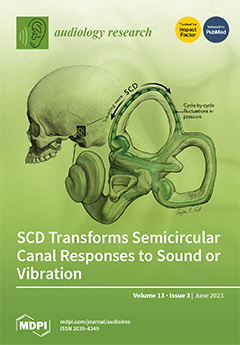Objective: To evaluate hearing outcomes at 2 years post endolymphatic duct blockage (EDB) surgery, with an analysis of factors that may predict hearing improvement.
Study Design: Retrospective comparative study.
Setting: Tertiary care center.
Subjects: Definite Ménière’s Disease (MD) patients undergoing EDB for refractory
[...] Read more.
Objective: To evaluate hearing outcomes at 2 years post endolymphatic duct blockage (EDB) surgery, with an analysis of factors that may predict hearing improvement.
Study Design: Retrospective comparative study.
Setting: Tertiary care center.
Subjects: Definite Ménière’s Disease (MD) patients undergoing EDB for refractory disease.
Methods: Chart review was conducted to assign cases to one of the three hearing outcome groups (deteriorated, stable, and improved). All cases that met our inclusion criteria were selected. Preoperative data collected were audiograms, bithermal caloric tests, preoperative vertigo episodes, history of previous ear surgery for Ménière, intratympanic steroid injections (ITS) and intraoperative endolymphatic sac (ELS) tear or opening. Postoperative data collected at 24 months were audiograms, vertigo episodes and bithermal caloric testing.
Results: Preoperative vertigo episodes, caloric paresis and history of surgery, ITS injections or ELS integrity, as well as postoperative vertigo class distribution and caloric paresis changes were not different between our groups. Preoperative word recognition score (WRS) was lowest in the improved hearing group (
p = 0.032). The persistence of tinnitus at 2 years postoperatively was associated with deteriorated hearing (
p = 0.033).
Conclusions: There are no strong predictors of hearing improvement on presentation pre-EDB, but low preoperative WRS may be the best estimator available. Therefore, ablative interventions should be considered very carefully in patients presenting with low WRS, as they may benefit more from EDB; there is a fair chance of a good hearing outcome with EDB surgery. Persistence of tinnitus can reflect deteriorating audition. Vertigo control and hearing preservation are independent outcomes of EDB surgery, making it desirable as an early intervention for refractory MD cases.
Full article






